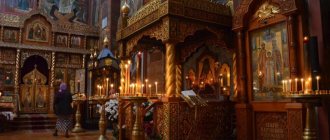Origin of the word
Archbishop is a rank of bishop. The word itself is Greek in origin and consists of several words: άρχή - “chief”, επί - “above”, σκοπος - “caretaker”. If put together and translated literally, it means “chief over the caretakers.” However, the word “bishop” itself comes from the whole word επίσκοπος and means “overseer.” Archbishop is the so-called “government” degree of bishop, the next rank is directly metropolitan.
History of the origin of the term
Under Emperor Constantine the Great, an administrative reorganization of the entire Roman Empire was carried out, which was divided into four prefectures. Each of them consisted of so-called dioceses, which in turn consisted of provinces. The civil structure completely coincided with the church structure. At that time, the archbishop was the chief bishop of the dicesis; he was also called an exarch (in Latin, vicar). This rank stood in the hierarchy after the patriarch - the head of the prefecture, but higher than the metropolitan. But in the Eastern Empire in the early Byzantine era, initially in the Patriarchate of Constantinople, the meaning of the word archbishop acquired a second meaning. This word began to be used to refer to bishops whose regions were located on the territory of the metropolitan district, but were removed from the direct department of the metropolitan himself and transferred to the subordination of the patriarch. Also, the archbishop began to occupy a lower place in the diptych than the metropolitan. In the end, this rank became a distinction of the bishop himself and is not associated with any special powers in comparison with simple bishops.
The meaning of the word archbishop
(Greek: "chief bishop")
rank, or title, of bishops. In the Russian Orthodox Church, below the rank of metropolitan. In some other Churches, this rank is higher than the rank of metropolitan and is assigned to the Primates of Autocephalous or Autonomous Churches. In literature, the first mentions of the title of archbishop appear in the middle of the 4th century. In the 5th century the use of the title archbishop becomes more frequent. For the first time, the rank of archbishop appears precisely in the meaning of the title of Primate of a larger entity than the ecclesiastical region headed by the metropolitan. The emergence of such formations is associated with the development of the administrative division of the Roman Empire, for the process of church centralization was aimed at bringing the organization of the Church into line with the new administrative division that had developed by the 4th century. Geographically, the empire was divided into 4 prefectures, which, in turn, were divided into dioceses. The civil heads of dioceses were called vicars. Then the metropolitans of the capital cities of dioceses, who acquired jurisdiction over other metropolitans of their dioceses, began to be titled vicars (or exarchs). Another title of exarchs was that of archbishop.
The exarchates, headed by archbishops, turned out to be unstable formations. The first bishops of these larger entities could retain, along with the titles of patriarch or pope, also the title of archbishop. Nowadays, along with the patriarchal title, the primates of the Constantinople, Georgian, Serbian and Romanian Churches have the title of archbishop. But from then on, primarily the Primates of Autocephalous Churches who did not have the patriarchal rank began to be called archbishops.
Currently, in addition to the Primate of the ancient Autocephalous Church of Cyprus, the rank of archbishop is held by the high priests of the Autocephalous Hellenic and Albanian Churches. Moreover, in accordance with the ancient meaning of the title, Primates of Churches with the rank of archbishop stand above Primates with the rank of metropolitan. The Primates of the Autonomous Churches: Sinai, Finland, and Japan are now also titled archbishops.
Meanwhile, already in the early Byzantine era in the East, initially in the Patriarchate of Constantinople, the title of archbishop began to be used in a different meaning. This is how they began to title bishops whose regions, being located on the territory of the metropolitan district, were withdrawn from the jurisdiction of the metropolitan and transferred to the direct jurisdiction of the patriarch. Such archbishops occupied places in the hierarchy below metropolitans. Even later, the rank of archbishop becomes only a distinction of a see or bishop, not associated with any special powers in comparison with those usual for bishops.
In the Russian Church the title of archbishop was first used in the 12th century. in relation to the Novgorod rulers, subsequently the bishops of other departments, in particular Rostov, Krutitsa, and later Kazan, began to be titled archbishops. In the Russian Orthodox Church, the title of archbishop has never been associated with special administrative powers and is only an honorary distinction, with archbishops occupying a position of seniority after metropolitans.
In the Orthodox Russian Church
There are many outstanding spiritual figures in Orthodoxy, for example Archbishop Luke, who became a victim of Stalinist repressions for his faith. The second primate of the Russian Orthodox Church, Metropolitan Leonty, who was part of the Patriarchate of Constantinople, was often also called an archbishop. However, in the future, absolutely all primates in Rus' were already called metropolitans. In Russia, archbishop is a title that was purely honorary and was in no way associated with any administrative duties and powers additional to the status of bishop. Starting from the twelfth century, the rulers of Novgorod began to be called this word. Then this title was used to refer to bishops of other departments: Krutitsa, Kazan, Rostov and others. Archbishop Luke also received this rank for his exceptional services to the Church in difficult times.
In modern world
In our time, the archbishop is the head of the autocephalous Church. Along with the patriarchs, this term also refers to the primates of Constantinople (Archbishop of New Rome - Constantinople), Archbishop of Tbilisi and Mtsekhi (Georgian Church), Archbishop of Pec (Serbian Church) and Bucharest (Romanian Church). The primates of the autonomous Churches - the Finnish and Sinai, as well as the Cretan semi-autonomous Church - are also named in the same way. In accordance with the established tradition in Russia, the rank of archbishop is an honorary distinction and is lower than the title of metropolitan. The situation is the same in both the Jerusalem and Georgian Churches. In autonomous and autocephalous Churches, the title of archbishop can be worn as the rank next to the metropolitan, that is, secondary. In the Bulgarian and Alexandrian Churches this rank is absent altogether.
ARCHBISHOP
[Greek ἀρχιεπίσκοπος, lat. archiepiscopus - chief bishop], rank, or title, of bishops. In the Russian Orthodox Church below the rank of metropolitan. In some other Churches this rank is higher than the rank of metropolitan and is assigned to the Primates of autocephalous or autonomous Churches.
In literature, the first mentions of the title A. appear in the middle. IV century Ep. Melitius of Lycopolis calls St. Alexander of Alexandria A. (Athanas. Alex. Apol. secund. 71). Melitius himself is titled A. by Epiphanius of Cyprus (Adv. haer. 68.1). OK. 383, the priests Faustinus and Marcellinus, in a letter to the emperors Valentinian II and Theodosius I the Great, title Pope Damasus I A. (PL. 13. Col. 98). In the 5th century the use of the title A. becomes more frequent. In the documents Vsel. III Council (431) Pope St. Celestine I (Act 1, etc.), ep. Cyril of Alexandria (Acts 5) are called A. In the Acts of the apostate assembly that took place parallel to the III Om. The cathedral, A. is named John I, bishop. Antioch, who presided over this meeting (DVS. T. 1. P. 283, 284, 286, 344). In the accusation against Bishop. Edessa Willow, dealt with by the Council of Antioch in 447/48, bishops of K-Polish Flavian and Antiochian Domnus II are called A. (Mansi. VII. Col. 220), they are titled A. and in the acts of the Council in Berita (Ibid. Col. 212 , 213, 231). The title A. is found in the documents of the Polish Councils against the Eutychians (Ibid. VI. Col. 652 sq., 769 sq.; cf.: IV Ecumenical Act 1st). OK. 450 Sozomen calls A. schmch. Simeon, bishop Ctesiphon and Seleucia (Hist. eccl. II 9). In the Acts of Chalcis. Council (451) for the title of bishops who headed the great church regions, “A.” is used in almost all cases: Pope St. Leo I the Great is called A. (see, for example, Section I, as well as Act 4 // DVS. T. 3. pp. 13-14, 24-25), ep. In the Epistle of the Archimandrites to the Council, Dioscorus I of Alexandria is titled A. (Ibid., p. 29), and Bishops Anatoly of K-Poland and Maximus of Antioch are also named (Acts 5 and 6).
It is in the meaning of the title of Primate of a larger formation than the church region headed by the metropolitan that the rank of A first appears. The emergence of such formations is associated with the development of adm. divisions of the Roman Empire, for the process of church centralization was aimed at bringing the organization of the Church into conformity with the new adm. division, which developed by the 4th century. Geographically, the empire was divided into 4 prefectures: Gaul, Italy, Illyricum and the East, the most extensive of all. At the same time, the two capitals of the empire - Rome and K-pol (New Rome) - had a special status and were not part of the prefectures. The prefectures were in turn divided into dioceses. The Prefecture of Gaul included Gaul proper, Britain, Spain and Mauritania; Italy - in addition to Italy, also Germany, Norik, Pannonia, Dalmatia, Epirus in the west of the Balkan Peninsula and Africa (with its capital Carthage); Illyricum with its center in Thessalonica - Macedonia, which also included the south of the Balkan Peninsula and Dacia. The Prefecture of the East included dioceses: Asia (with its center in Ephesus), which united the provinces located in the southwest. parts of M. Asia; Pontus, with its capital in Caesarea Cappadocia, occupied the north-east. part of the Asia Minor Peninsula, and the Armenian Highlands; Thrace (the eastern tip of the Balkan Peninsula with a center in Iraklia), on the territory of which the new capital of the empire, K-pol, was located, without being administratively part of it; Syria (with its capital Antioch) and Egypt with Libya and Pentapolis (the main city is Alexandria), as well as Cyprus. Each diocese included several. provincial
The civil heads of dioceses were called vicars (Latin vicarius, Greek βικάριος). Then the metropolitans of the capital cities of dioceses, or great regions (II Om. 2), who acquired jurisdiction over other metropolitans of their dioceses, began to be titled vicars (Greek ἔξαρχος - exarch). Dr. the title of the exarchs was the title A. It is in this meaning that they are known from the church titulary of the 4th century. A. Caesarea Cappadocia, Antioch, Ephesus, Alexandria.
The exarchates, headed by A., turned out to be unstable formations: in the 5th-7th centuries. some of them (Alexandrian, Antioch) grew to the status of Patriarchates, others - Pontic, Asian and Thracian - with departments in Caesarea Cappadocia, Ephesus and Heraclius, united and formed the newly formed K-Polish Patriarchate. The Patriarchate of Jerusalem (within the borders of Palestine) emerged from the Antioch (Syrian) diocese. In lat. half of the empire, the power of the Bishop of Rome extended first to Italy, and then to the entire West. At the same time, the first bishops of these larger entities could retain, along with the titles of patriarch or pope, also the title A. Nowadays, the title A. is held, along with the Patriarchal Primate of the Churches: K-Polish, Georgian (Archbishop of Mtskheta and Tbilisi), Serbian (Archbishop of Pec) and Romanian (Archbishop of Bucharest).
But from then on, predominantly A. began to call the Primates of the autocephalous Churches, which did not have the Patriarchal rank: the First Bishop of the Cyprus Church, Bishop of New. Justinians, with whom the Ohrid Archdiocese and the Bulgarian Patriarchate are successively associated, although now the title of A. Nov. Justinian is worn by the Primate of the Cyprus Church. Currently time, in addition to the Primate of the ancient autocephalous Cypriot Church, the rank of A. is held by the High Hierarchs of the autocephalous Hellenic and Albanian Churches. Moreover, in accordance with the ancient meaning of the title, Primates of Churches in the rank of A. are higher in the diptych of Primates with the rank of metropolitan. But the Primates of the autocephalous Churches of the Czech lands and Slovakia, the Orthodox Church in America, along with the title of metropolitans, also have the title of Metropolitan: the first - of Prague, the second - of Washington. A. The Primates of the autonomous Churches are now also titled: Sinai, Finland; The head of the Japanese Autonomous Church, along with the rank of metropolitan, also has the title of A. Tokyo.
Meanwhile, already in the early Byzantine period. era in the East, initially in the K-Polish Patriarchate, the title A. began to be used in a different meaning. A. began to give titles to bishops whose regions, being in the territory of the metropolitan district, were withdrawn from the jurisdiction of the metropolitan and transferred to the direct jurisdiction of the Patriarch. Such A. (ἀρχιεπίσκοποι αὐτοκέφαλοι) occupied places in the diptychs below the metropolitan ones. Even later, the rank of A. becomes only a distinction of a see or bishop, not associated with any special powers in comparison with those usual for bishops.
In the Russian Church the title A. was first used in the 12th century. in relation to the Novgorod rulers, later. Bishops of other departments, in particular Rostov, Krutitsa, and later Kazan, also began to be titled A. In the Russian Orthodox Church, the title A. was never associated with special adm. powers and is only an honorary distinction, while A. occupy a position of seniority after the metropolitans. At different times, the title of A. was assigned to bishops in the Russian Orthodox Church on different grounds: depending on the rank of the department - this was primarily the case in the pre-Synodal era, as well as in certain periods of the Synodal era (in the 18th century, after 1764, - depending on the class of the diocese ), in other periods of the synodal era, the rank of A. was a personal distinction of the bishop. This is how things stand in the Russian Orthodox Church today. time.
In the Roman Catholic Church, the title of A. received a meaning identical to the meaning of the title of ancient metropolitans: an ecclesiastical province, which includes several. dioceses, is headed by “the metropolitan, who is the archbishop of the diocese he governs” (CIC can. 435). In the Anglican Church, the title of A. is borne by its primate, the Archbishop of Canterbury; the head of the 2nd ecclesiastical province of England, the Archbishop of York, also has the archbishop's title. Among the members of the Anglican Commonwealth, the rank of A. or A. Metropolitan is held by the heads of Churches or ecclesiastical provinces in Ireland, Australia, etc.
Lit.: Zaozersky N. About church authority. Serg. P., 1894; Nicodemus [Milash], bishop. Right. P. 291; Gidulyanov P.V. Eastern Patriarchs during the period of the first four Ecumenical Councils. Yaroslavl, 1908; Amanieu A. Archevêque // DDC. T. 1. Col. 928-934; Maxime des Sardes, metrop. Le Patriarcat œcumenique dans l'Église Orthodoxe. P., 1975; ̓Ιάκωβος (Πηλίλης), ἐπ. ὀφφίκια καὶ ἀξιώματα ἐν τῇ βυζαντινῇ αὐτοκρατορίᾳ καὶ τῇ χρ ιστιανικῇ ὀρθοδόξῳ ̓Εκκλησίᾳ. ̓Αθῆναι, 1985. Σ. 141-147.
Prot. Vladislav Tsypin







